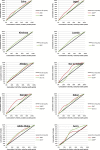Inequalities in child mortality in ten major African cities
- PMID: 24906463
- PMCID: PMC4066831
- DOI: 10.1186/1741-7015-12-95
Inequalities in child mortality in ten major African cities
Abstract
Background: The existence of socio-economic inequalities in child mortality is well documented. African cities grow faster than cities in most other regions of the world; and inequalities in African cities are thought to be particularly large. Revealing health-related inequalities is essential in order for governments to be able to act against them. This study aimed to systematically compare inequalities in child mortality across 10 major African cities (Cairo, Lagos, Kinshasa, Luanda, Abidjan, Dar es Salaam, Nairobi, Dakar, Addis Ababa, Accra), and to investigate trends in such inequalities over time.
Methods: Data from two rounds of demographic and health surveys (DHS) were used for this study (if available): one from around the year 2000 and one from between 2007 and 2011. Child mortality rates within cities were calculated by population wealth quintiles. Inequality in child mortality was assessed by computing two measures of relative inequality (the rate ratio and the concentration index) and two measures of absolute inequality (the difference and the Erreyger's index).
Results: Mean child mortality rates ranged from about 39 deaths per 1,000 live births in Cairo (2008) to about 107 deaths per 1,000 live births in Dar es Salaam (2010). Significant inequalities were found in Kinshasa, Luanda, Abidjan, and Addis Ababa in the most recent survey. The difference between the poorest quintile and the richest quintile was as much as 108 deaths per 1,000 live births (95% confidence interval 55 to 166) in Abidjan in 2011-2012. When comparing inequalities across cities or over time, confidence intervals of all measures almost always overlap. Nevertheless, inequalities appear to have increased in Abidjan, while they appear to have decreased in Cairo, Lagos, Dar es Salaam, Nairobi and Dakar.
Conclusions: Considerable inequalities exist in almost all cities but the level of inequalities and their development over time appear to differ across cities. This implies that inequalities are amenable to policy interventions and that it is worth investigating why inequalities are higher in one city than in another. However, larger samples are needed in order to improve the certainty of our results. Currently available data samples from DHS are too small to reliably quantify the level of inequalities within cities.
Figures


References
-
- Sahn DE, Stifel DC. Urban–rural inequality in living standards in Africa. J Afr Econ. 2003;12:564–597. doi: 10.1093/jae/12.4.564. - DOI
-
- Barros AJ, Ronsmans C, Axelson H, Loaiza E, Bertoldi AD, França GV, Bryce J, Boerma JT, Victora CG. Equity in maternal, newborn, and child health interventions in Countdown to 2015: a retrospective review of survey data from 54 countries. Lancet. 2012;379:1225–1233. doi: 10.1016/S0140-6736(12)60113-5. - DOI - PubMed
Publication types
MeSH terms
LinkOut - more resources
Full Text Sources
Other Literature Sources
Molecular Biology Databases

